paleomaxx
Hero Member
- Joined
- Aug 14, 2016
- Messages
- 841
- Reaction score
- 6,888
- Golden Thread
- 6
- Location
- Upstate, NY
- 🥇 Banner finds
- 6
- Detector(s) used
- Deus XP
- Primary Interest:
- All Treasure Hunting
I learned two things on Saturday. The first is that bolt-cutters do not belong in a colonial site but are still occasionally found, and second that it really pays to cover your ground again! 
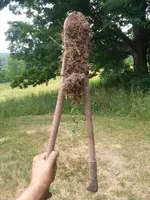
All of these finds (including the bolt-cutters) were from the same spot and in areas that I had already covered at least once and in a few cases multiple times. Unfortunately we still haven't had much rain so I'm sure I'm missing smaller and deeper targets, but for a 2 hour hunt it was tremendous. Almost right off the bat I found a coin that's near the top of my bucket list, a 1783 Nova Constellatio!
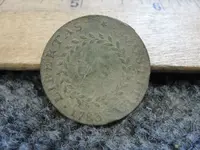
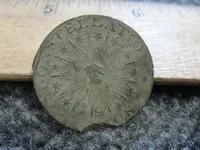
It looks like a plow or some other earth mover hit it a long time ago, but the design is very well preserved and everything present and legible! I know these were probably minted after the date that appears on them, but to hold a coin that has the date 1783 and says "US" is just incredible.
Shortly after I dug that, another coin appeared with the familiar Vermont landscape features. This one had the date 1785 and was also in spectacular shape, but it wasn't until I got home and started cleaning and identifying it that I realized what I had:
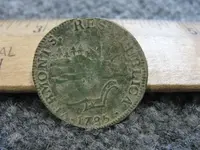
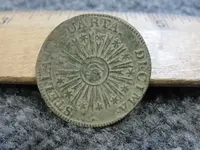
I looked at the varieties for 1785 and it seems I have a Ryder 3 which is listed as rare! How rare; according to Heritage Auctions perhaps only 50 or 60 surviving! To find two landscape coppers at the same site and in such fantastic condition is already amazing, but for one to be a rarity even in the coin world is crazy!
To find two landscape coppers at the same site and in such fantastic condition is already amazing, but for one to be a rarity even in the coin world is crazy!
Those were the only two coins to pop up, which is actually good since it means I got the lion's share in the first pass (don't want to be missing those good coins too often ), but there were plenty of relics. Some decent period buttons popped up including another nice dandy with a pretty black patina.
), but there were plenty of relics. Some decent period buttons popped up including another nice dandy with a pretty black patina.
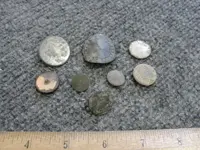

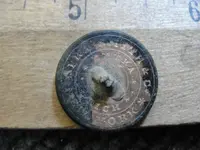
I also found an 1830's brass flat with a ton of the gold gilt left on it. This included the maker: "Ira Smith & Co New York." I couldn't find too much online about the buttons, but there are mentions of a merchant by that name operating out of New York, so maybe it was a small batch ordered for advertising.
There was one more button that I thought was another plain convex, but after cleaning a design appeared. The etchings were very thin so its hard to make out between the patches of patina, but there's definitely an 8-pointed star and a design in the center of the star.
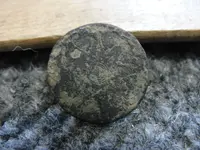
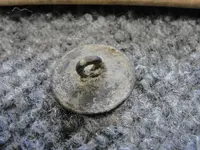
I may be biased because I've been seeing it on so many coins and photos online, but it resembles an eye of providence to me. What do you guys think, and if so, what on earth would someone be doing with that on a button? I can't find anything like that online and it wasn't a masonic symbol until 1797 and based on the construction this button predates that.
Conspiracy theories aside, this hunt also produced my new oldest buckle: a 1660-1720 stud chape buckle!
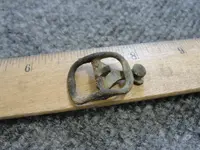
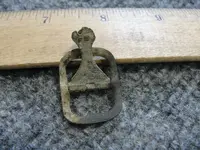
It's really tiny, but in great shape and one of my oldest finds ever! I also found this cool pocket knife that unfortunately broke apart, but has some interesting floral designs along the brass sides.
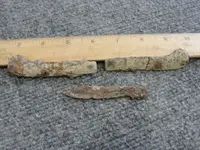
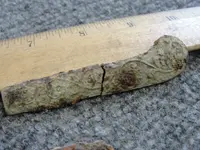
There were also quite a few more bits of melted metal including one that appears to be a partially melted shoe buckle fragment and a lead rod. I'm now very sure that this was a small foundry and that might also explain the large amount of coinage.
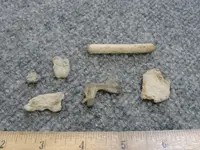
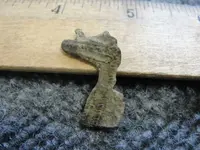
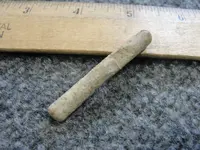
There were also a few odd brass pieces:
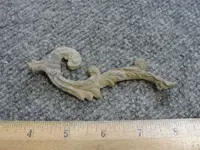
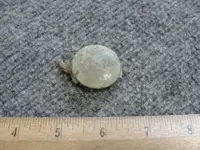
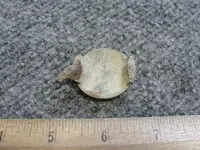
Not sure what either one is from, but the first is very ornate in quite heavy.
I suspect that the dry soil and iron is masking a lot of the smaller targets. Even big pieces of brass that were 4 inches down would read far under their usual signal on the Deus and some targets were barely audible at 6 inches. I think if I hit this ground in early spring it'll be like a brand-new site again, but until then I think the high-grass areas are becoming very enticing. I may have to do so mowing because there's no way I can wait until next Spring to cover the rest of this site!


All of these finds (including the bolt-cutters) were from the same spot and in areas that I had already covered at least once and in a few cases multiple times. Unfortunately we still haven't had much rain so I'm sure I'm missing smaller and deeper targets, but for a 2 hour hunt it was tremendous. Almost right off the bat I found a coin that's near the top of my bucket list, a 1783 Nova Constellatio!


It looks like a plow or some other earth mover hit it a long time ago, but the design is very well preserved and everything present and legible! I know these were probably minted after the date that appears on them, but to hold a coin that has the date 1783 and says "US" is just incredible.
Shortly after I dug that, another coin appeared with the familiar Vermont landscape features. This one had the date 1785 and was also in spectacular shape, but it wasn't until I got home and started cleaning and identifying it that I realized what I had:


I looked at the varieties for 1785 and it seems I have a Ryder 3 which is listed as rare! How rare; according to Heritage Auctions perhaps only 50 or 60 surviving!
 To find two landscape coppers at the same site and in such fantastic condition is already amazing, but for one to be a rarity even in the coin world is crazy!
To find two landscape coppers at the same site and in such fantastic condition is already amazing, but for one to be a rarity even in the coin world is crazy! Those were the only two coins to pop up, which is actually good since it means I got the lion's share in the first pass (don't want to be missing those good coins too often
 ), but there were plenty of relics. Some decent period buttons popped up including another nice dandy with a pretty black patina.
), but there were plenty of relics. Some decent period buttons popped up including another nice dandy with a pretty black patina. 


I also found an 1830's brass flat with a ton of the gold gilt left on it. This included the maker: "Ira Smith & Co New York." I couldn't find too much online about the buttons, but there are mentions of a merchant by that name operating out of New York, so maybe it was a small batch ordered for advertising.
There was one more button that I thought was another plain convex, but after cleaning a design appeared. The etchings were very thin so its hard to make out between the patches of patina, but there's definitely an 8-pointed star and a design in the center of the star.


I may be biased because I've been seeing it on so many coins and photos online, but it resembles an eye of providence to me. What do you guys think, and if so, what on earth would someone be doing with that on a button? I can't find anything like that online and it wasn't a masonic symbol until 1797 and based on the construction this button predates that.
Conspiracy theories aside, this hunt also produced my new oldest buckle: a 1660-1720 stud chape buckle!


It's really tiny, but in great shape and one of my oldest finds ever! I also found this cool pocket knife that unfortunately broke apart, but has some interesting floral designs along the brass sides.


There were also quite a few more bits of melted metal including one that appears to be a partially melted shoe buckle fragment and a lead rod. I'm now very sure that this was a small foundry and that might also explain the large amount of coinage.



There were also a few odd brass pieces:



Not sure what either one is from, but the first is very ornate in quite heavy.
I suspect that the dry soil and iron is masking a lot of the smaller targets. Even big pieces of brass that were 4 inches down would read far under their usual signal on the Deus and some targets were barely audible at 6 inches. I think if I hit this ground in early spring it'll be like a brand-new site again, but until then I think the high-grass areas are becoming very enticing. I may have to do so mowing because there's no way I can wait until next Spring to cover the rest of this site!
Amazon Forum Fav 👍
Upvote
30




